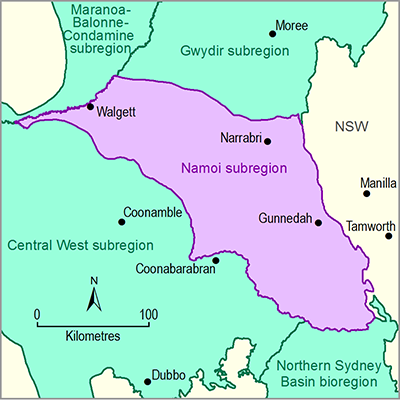Summary
Findings from this Assessment can help governments, industry and the community in providing better-informed regulatory water management and planning decisions. Assessment results flag where future efforts of regulators and proponents can be directed, and where further attention is not necessary.
Modelling of drawdown and surface water flow interception from eight additional coal resource development predicted changes in flow in a number of streams, where there was sufficient information for surface water modelling, with more low flows, and fewer high flows and overbank events. These changes in the streamflow lead to potential risks to the ‘Floodplain or lowland riverine’ and ‘Non-floodplain or upland riverine’ landscape groups.
Post-assessment monitoring is important to test and (in)validate the risk predictions of the assessment. At the highest level, monitoring efforts should reflect the risk predictions, and focus the effort where changes are potentially the largest and incorporate those areas where modelling limitations did not allow the risk to be quantified. However, it is important to place some monitoring effort at locations with lower risk predictions so as to confirm the range of potential impacts and identify unexpected outcomes.
Besides monitoring, there are a number of data-sparse areas where drawdown intersects with streams, and where the absence of surface water data made it impossible to construct and apply surface water models. These areas would benefit from consistent and regular data collection, which would improve the risk quantification of this Assessment. This includes surface water and ecological baseline data collection to establish an understanding of the environmental conditions.
Work on identifying and monitoring the hydrological conditions that relate to groundwater and subsurface flows and their limits that sustain subsurface biota would also improve this Assessment further, especially when co-located with hydrological monitoring areas that also collect data to improve the knowledge on surface water – groundwater interaction.
The assessment’s probabilistic approach used a wide array of parameterisations to represent the possibility of highly conductive, highly connected landscapes through to low-conductivity, poorly connected landscapes. These result sets are intended to span the hydrological changes that may occur, help ensure that the zone of potential hydrological change is conservative, and allow bioregional assessments (BAs) to make strong statements about non-impact for landscape classes or assets that are outside the zone. Better data will not necessarily improve the hydrological model predictions from the regional-scale model, but could potentially contribute to constraining model results for local-scale application.
Improved mapping of depth to groundwater, and its spatial and temporal variation, not only has potential to constrain hydrological change predictions, but it provides much needed context for the interpretation of the ecological impacts due to hydrological change.
Ecological risk is quantified using receptor impact models, and based on experts’ understanding of the receptor impact variables over large areas and time frames relevant to the ecosystem’s water requirement. As a consequence, predictions of receptor impact variables at specific locations reflect the response across the landscape class the experts would expect to occur given the hydrological conditions at that location. The usefulness of the receptor impact models is in identifying the risk to areas, based on the hydrological changes, and highlighting these areas that warrant priority for further investigation. These priority areas require consideration in conjunction with those where a lack of hydrological modelling prevented receptor impact modelling outputs.
BAs have been developed with the ability to be updated, for example, to incorporate new coal resource developments in the groundwater model. Existing datasets, such as the water-dependent asset register, remain relevant for future assessments.
The full suite of information, including information for individual assets, is available at www.bioregionalassessments.gov.au.

Product Finalisation date
- 3.1 Overview
- 3.2 Methods
- 3.3 Potential hydrological changes
- 3.4 Impacts on and risks to landscape classes
- 3.4.1 Overview
- 3.4.2 Landscape classes that are unlikely to be impacted
- 3.4.3 'Floodplain or lowland riverine' (non-Pilliga) landscape group
- 3.4.4 'Non-floodplain or upland riverine' (non-Pilliga) landscape group
- 3.4.5 Pilliga riverine (upland and lowland)
- 3.4.6 Potentially impacted landscape classes lacking quantitative ecological modelling
- References
- Datasets
- 3.5 Impacts on and risks to water-dependent assets
- 3.6 Commentary for coal resource developments that are not modelled
- 3.7 Conclusion
- Citation
- Acknowledgements
- Contributors to the Technical Programme
- About this technical product
